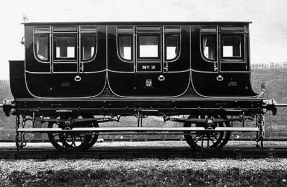
In Part One of this article I reviewed the background, opening and operation of the Burry Port & Gwendraeth Valley Railway (BP&GVR) its traffic and its locomotives and rolling stock. In Part Two we travel the line and take the story to its sad and somewhat inevitable end.
A journey from Burry Port to Cwmmawr
Let us now take an imaginary trip along the BP&GVR. The 12¾-mile ‘main line’ route from Burry Port to Cwmmawr is single track throughout. In earlier BP&GVR days the rails were flat-bottom steel 75 and 81lb per yard, not chaired but secured by bolts to sleepers. For our journey in 1952 we observe that the running track is generally characterised by a mass of weeds.
Most trains on the branch consist of a locomotive and two coaches but our train, the 1.45pm Burry Port to Cwmmawr (a service observed by J. Bourne writing in Trains Illustrated in 1952) provides a nice contrast. It comprises four coaches: including two of Burry Port's four-wheelers (Burry Port is said to be the last GWR stronghold of fourwheeled passenger coaches) with two of the last GWR-designed locomotives at its head. They are Nos.1609 and 1633: two of Frederick Hawksworth's Class ‘16XX’ 0-6-0PTs. In the words of J. Bourne “The sight of two Class 16XX engines hauling two four-wheeled and two ex-B.P.G.V. coaches is stirring to say the least.”


There are four passenger trains daily from Burry Port to Cwmmawr (weekdays only) with an additional train on Saturdays and five services daily in the reverse direction. One workmen's train runs from Burry Port to Cwmmawr each weekday.
For the first half of our journey the line is laid alongside an old canal bed and is consequently quite level. The very low height of some of the overbridges on this section is a reminder of the original canal conversion. Being legally a Light Railway all trains on this section are restricted to a maximum speed of 25mph but there are additional restrictions to 10mph or 5mph over the numerous ungated level crossings. No crossing keepers are employed but road traffic is light so highway users have to watch out for themselves.
We depart from the separate BP&GVR staffed station at Burry Port. Here we are introduced to the typical BP&GVR station – best described as basic. On the northern side of the single line sits the single short earthtype platform with brick facings upon which is a small corrugated ironPort station, not typically, also rejoices in the provision of a brick-built toilet block. There is also a water column which both our locomotives have used. The station has a runround passing loop and two carriage sidings, one of which also serves a goods shed.






